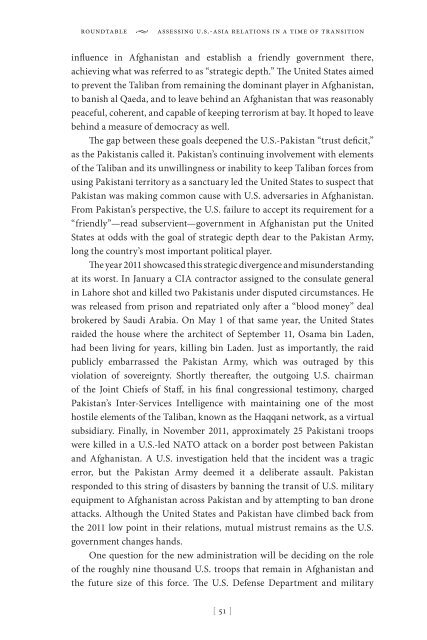2jBVKVf
2jBVKVf
2jBVKVf
You also want an ePaper? Increase the reach of your titles
YUMPU automatically turns print PDFs into web optimized ePapers that Google loves.
oundtable • assessing u.s.-asia relations in a time of transition<br />
influence in Afghanistan and establish a friendly government there,<br />
achieving what was referred to as “strategic depth.” The United States aimed<br />
to prevent the Taliban from remaining the dominant player in Afghanistan,<br />
to banish al Qaeda, and to leave behind an Afghanistan that was reasonably<br />
peaceful, coherent, and capable of keeping terrorism at bay. It hoped to leave<br />
behind a measure of democracy as well.<br />
The gap between these goals deepened the U.S.-Pakistan “trust deficit,”<br />
as the Pakistanis called it. Pakistan’s continuing involvement with elements<br />
of the Taliban and its unwillingness or inability to keep Taliban forces from<br />
using Pakistani territory as a sanctuary led the United States to suspect that<br />
Pakistan was making common cause with U.S. adversaries in Afghanistan.<br />
From Pakistan’s perspective, the U.S. failure to accept its requirement for a<br />
“friendly”—read subservient—government in Afghanistan put the United<br />
States at odds with the goal of strategic depth dear to the Pakistan Army,<br />
long the country’s most important political player.<br />
The year 2011 showcased this strategic divergence and misunderstanding<br />
at its worst. In January a CIA contractor assigned to the consulate general<br />
in Lahore shot and killed two Pakistanis under disputed circumstances. He<br />
was released from prison and repatriated only after a “blood money” deal<br />
brokered by Saudi Arabia. On May 1 of that same year, the United States<br />
raided the house where the architect of September 11, Osama bin Laden,<br />
had been living for years, killing bin Laden. Just as importantly, the raid<br />
publicly embarrassed the Pakistan Army, which was outraged by this<br />
violation of sovereignty. Shortly thereafter, the outgoing U.S. chairman<br />
of the Joint Chiefs of Staff, in his final congressional testimony, charged<br />
Pakistan’s Inter-Services Intelligence with maintaining one of the most<br />
hostile elements of the Taliban, known as the Haqqani network, as a virtual<br />
subsidiary. Finally, in November 2011, approximately 25 Pakistani troops<br />
were killed in a U.S.-led NATO attack on a border post between Pakistan<br />
and Afghanistan. A U.S. investigation held that the incident was a tragic<br />
error, but the Pakistan Army deemed it a deliberate assault. Pakistan<br />
responded to this string of disasters by banning the transit of U.S. military<br />
equipment to Afghanistan across Pakistan and by attempting to ban drone<br />
attacks. Although the United States and Pakistan have climbed back from<br />
the 2011 low point in their relations, mutual mistrust remains as the U.S.<br />
government changes hands.<br />
One question for the new administration will be deciding on the role<br />
of the roughly nine thousand U.S. troops that remain in Afghanistan and<br />
the future size of this force. The U.S. Defense Department and military<br />
[ 51 ]


